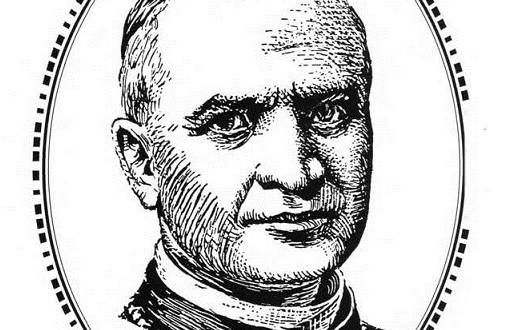by Albert Cizauskas
A Man for All Reasons: Jurgis Matulaitis
“What a piece of work is man! How noble in reason! How infinite in faculty!…In action, how like an angel!” – Shakespeare
ARCHBISHOP JURGIS (GEORGE) MATULAITIS is revered for his adamant refusal tolerate politics within the Church. For this and for a life of brilliant achievement while suffering from crippling attacks of cancer, he was declared “Blessed” during ceremonies in 1987 at Rome commemorating Lithuania’s 600th year of Christianity. In ways that defined his character, Jurgis Matulaitis resembled Thomas More. Both were persons of deep piety and learning, both were practical men of affairs with an illustrious record of achievement, both refused to compromise the high office they held for principles they held dearer and both, in the end, suffered martyrdom, Matulaitis by losing the bishopric of Vilnius and More by losing his head.
A Promising Theologian
Born in the village o f Lugine near Marijampole on April 13, 1871, and orphaned at an early age, Jurgis was sent by relatives in Poland to seminaries in that country. There he distinguished himself by winning the highest honors. His Polish background was a mixed asset, however. While it gave him an intimate insight into the Polish character, it made him suspect to Lithuanian partisans who regarded Matulaitis as a supporter of the Polish cause. Nor did it help him with the Poles who looked down on him for not denying his Lithuanian heritage.
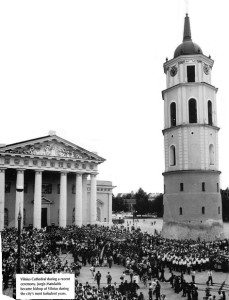
Another important influence on the formation of Maailaitis’ character was the contraction of bone cancer. The deadly malady incapacitated him on numerous occasions and its searing pain afflicted him through his relatively short life of 56 years. Because of the cancer he was compelled to give up parish work in Poland at the start of his clerical career and seek medical treatment in Germany. There his restless spirit refused to accept the usual constraints binding an invalid and managed to attend the University of Fribourg in Switzerland where he w on a Doctorate in Sacred Theology. Additional honors came his way, bringing him to the attention of Church leaders.
After a partial recovery, M atulaitis was assigned to teach at a Polish seminary but once again his cancer flared up, and it was even feared one of his legs might have to be amputated. As his condition again improved, the young theologian began to probe deeply into theories of social justice, which were then at the forefront of intellectual inquiry, from Marxism at one end, to Papal encyclicals at the other. He translated theory into practice by founding in Warsaw a labor union which attracted over 50,000 members, and edited its journal. He also recruited students for Christian social action. With the spirit of a crusader he organized “social action w eeks” in Warsaw an d K aunas, thereby dem onstrating that not only socialists but also the C hurch w as c o n cerned about the exp lo ita tio n of th e E u ro p e a n w o rk er. Christian social action, of which Matulaitis was an early and effective exponent in Poland and Lithuania, was one of the important forces which helped counter the spread of communism in eastern Europe.
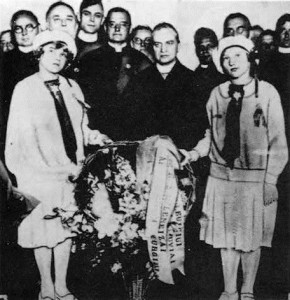
In 1907, he was appointed the first occupant of the chair of sociology at the prestigious Academy of St. Petersburg. Matulaitis’ keen intellect, deep knowledge and thorough teaching of practical social problems attracted not only students but even professors at the Academy. He kept climbing up the academic ladder, but his boundless energies sought an outlet in an unexpected way.
Revival of the Marians
It was at this time that he successfully petitioned the Pope to let him restore the Marian order of which only one monk remained. The Marians had been founded in 1673 in Poland to teach the poor and grew rapidly with communities established in Lithuania, Italy, and Portugal. Religious persecution, however, soon dealt it virtually mortal blows.
And so it came about that a Lithuanian restored an order founded by a Pole. With enthusiasm and zeal he began the immense work of bringing back to life a religious community on the verge of extinction. Matulaitis revised the order’s rule and brought it into the 20th century, seeing monasticism not solely as a means of personal sanctification but also as a dynam o to promote social action and cultural life. Marian comm unities w ere fou n d ed in seven countries. The work of the rejuvenated order can best be illustrated by its activities in Lithuania where its members taught primary and secondary schools, operated model farms, craft workshops and printing presses, and ran libraries and theatrical facilities.
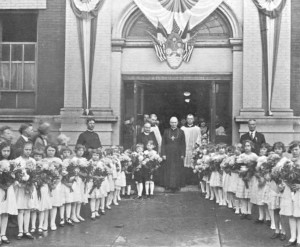
In today’s spirit of giving women a more meaningful role in the religious life of the Church, Matulaitis established a congregation called the Sisters of the Immaculate Conception. Like its male counterpart, the women’s order prospered and expanded. In the United States it concentrated in the fields of nursing, caring for preschool age children and the aged.
Matulaitis in America
The founder of the modernized Marian order made two visits to the United States. The first took place in 1913 when he established a branch of the Marian order in Chicago. Remarkably, this occurred five years earlier than in Lithuania itself, a singular recognition by Matulaitis of the rapid growth and im portance of the Lithuanian Catholic community in this country. By 1963, fifty years later, the thriving Marians numbered over one hundred priests in monasteries in midwest and northeast states.
Matulaitis returned as an archbishop in 1926 to represent Lithuania at the 28th Eucharistic Congress. The energetic prelate took advantage of the opportunity to visit scores of Lithuanian parishes where he preached, administered the sacrament of confirmation and even, on one notable occasion, engaged in public debate with Lithuanian socialists.
The seed which Matulaitis had planted here had clearly taken root. One of its more noted manifestations has been the publication of the daily, Draugas, a leading political, cultural, and religious voice of the Lithuanian American Catholic community for many years.
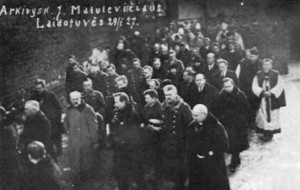
War
Despite the immediate success of the order, the times were out of joint and the new Marians underwent considerable difficulties in Poland and Lithuania. The war between the Germans and the Russians inflicted untold hardships upon the Marians and the people they served. On top of his organizational work, Matulaitis found the time to open a shelter for war orphans and even begged in person on the streets of Warsaw to help the helpless ones. His courageous and selfless work came to the attention of Monsignor Achille Ratti, the Vatican’s representative in Poland. The two soon became warm friends. When Ratti was elevated to the rank of Archbishop, he placed himself for a period of eight days under Matulaitis’ spiritual guidance in preparation for this exalted step. It was not surprising that when the Archbishop returned to Rome, he became an ardent supporter of the energetic humanitarian priest.
The Reluctant Bishop
In the waning days of World War I, the Vatican appointed Matulaitis as Bishop of Vilnius despite widespread opposition from both Poles and Lithuanians. Matulaitis made it plain, however, that he would be the shepherd of all his flock. At the same time he petitioned the Vatican to release him from an honor which he correctly foresaw would bring him nothing but anguish and frustration.
The corrosive spirit of ethnic politics intruded even into his investiture ceremonies. A heated controversy erupted about the language he should use in his first formal address to the people of the city. Matulaitis adopted a simple but elegant solution. He addressed the Cathedral’s clergy in Latin, then the congregation in Polish and Lithuanian. While this procedure did not please all, it satisfied most. It did not go unnoticed by the Polish element, however, that the new Bishop’s address in Lithuanian is said to have been the first since the 15th century that Lithuanian had been heard in the Vilnius Cathedral.
No sooner had the Lithuanian Bishop of a mixed Polish-Lithuanian diocese been installed than a murderous conflict to control the city erupted between the Poles and the Russians. As Bishop, Matulaitis helped calm the people of the contested city and even gave asylum at grave personal risk to those out of favor, including Jews who for centuries had looked upon Vilnius as their “Second Jerusalem ”. In his diary, the Bishop exclaimed with an emotion that arose out of the depths of his troubled soul: “Oh God, how strange is this world! The same people who cried out against capital punishment are now them selves killing their captured enemies”.
Matulaitis endured six military occupations while Bishop. The city’s in habitants suffered greatly from the maddening see-saw of military advance and retreat. Finally, Polish legions capaired the city and ignored a League of Nations m and ate th at the city be turned over to the Lithuanians. The Polish occupation was exceptionally harsh and lasted until the German invasion of Poland in 1939.
Matulaitis found the time to open a shelter for war orphans and even begged in person on the streets of Warsaw to help the helpless ones.
The End of the Road
After seven bitter years, the end of Matulaitis’ time of trial was in sight. In 1925 Poland reached an accord with the Holy See which recognized Polish sovereignty over Vilnius. The Vatican was also prepared to elevate the diocese of V ilnius to an archbishopric. The longsuffering prelate knew that the Polish government would never permit a “Litvomanis” to be the first Archbishop of that unhappy city. So the Lithuanian Bishop of Vilnius wrote to Ratti, then Pope Pius XI, explaining once again his vulnerability under Polish harassment, his inability to perform his duties, and his disinclination to stand in the way of Vilnius’ elevation. He asked instead that he be permitted to live in Rome and work for the Marian order. His friend, the Pope, agreed.
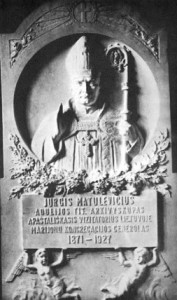
After a few months in Rome, the Pope demonstrated his appreciation of what Matulaitis had accomplished and was determined not to deny him of the honor he so richly deseived. The Bishop was invested with the rank of tiailar Archbishop (that is, one without diocese) and was sent to inspect the Lithuanian ecclesiastical establishment, a procedure that normally excluded a native son.
The new assignment was particularly difficult because Lithuanian relations with the Vatican were strained over the Vilnius affair. With customary tact, perseverance and zeal, however, Maailaitis accomplished his task and even went beyond it. He proposed to Rome the formation of a separate province for Lithuania with five dioceses and five Bishops. The Pope concurred. For the first time the Lithuanian Church was to enjoy an independent life of its own. Matulaitis’ w ork was crow ned with a Concordat (a formal agreement between the Holy See and a secular state, regulating relations with each other).
The new Archbishop sent his report to Rome, but before he could return to the Vatican he died suddenly of acute appendicitis on January 27, 1927.
The Encyclopedia Lithuanica memorialized Archbishop Matulaitis with the following words: “(his) exemplary life, his resoluteness, unusual gentleness, and deep intellect impressed everyone who knew him.”
His other Papal supporter, Pius XII (Eugenio Pacelli), initiated the process of beatification in 1952. By a happy coincidence the beatification was concluded by a Polish Pope on June 28,1987 who said of this extraordinary man: “(Matulaitis) was one who in a heroic manner made himself ‘All things to all people’, a person conscious of his own pastoral mission, a true apostle of unity”
Ever since Jogaila had accepted the Polish crow n in exchange for the Christianizing of Lithuania, the Church there had suffered under a cloud of Polish nationalism. In a life full of achievement, the Archbishop’s major legacy to his people was to divorce religion from politics. Like Thomas More, Jurgis Matulaitis knew where to draw the line.
Please note: We appologize to our readers for the quality of some of the photographs used to illustrate this article. These are vintage archival photographs, and they are the best we could obtain of Blessed Jurgis Matulaitis.
 DRAUGAS NEWS Lithuanian World Wide News in English
DRAUGAS NEWS Lithuanian World Wide News in English
